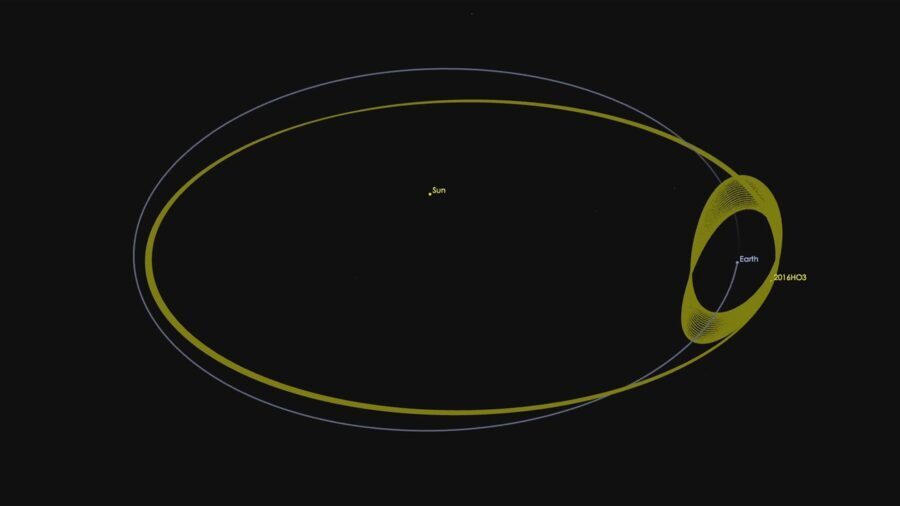
Recently discovered asteroid 2023 FW13 has created a bit of a stir among asteroid watchers. It turns out to be on an orbit that is not only in a 1:1 resonance with the Earth, but follows a path that actually circles Earth — albeit on an orbit that is so eccentric that it sweeps out halfway to Mars and in halfway to Venus.
There's no formal definition for objects such as this, which are sometimes called quasi-moons or quasi-satellites. They follow a path around Earth, but usually for no more than a few decades. Perhaps the best known of these objects, known as Kamoʻoalewa, was found in 2016, and is considered the smallest, closest, and most stable known quasi-satellite. It has an orbit that has been in a stable resonance with Earth for almost a century, and will remain so for centuries to come, according to calculations by Paul Chodas (Jet Propulsion Laboratory).
But this newfound asteroid, if preliminary orbital calculations are correct, will handily eclipse that record. Some estimates say it has circled Earth since at least 100 BC and will likely continue to do so until around AD 3700. If that's correct, 2023 FW13 would be the most stable quasi-satellite of Earth ever found.
The asteroid was first observed March 28th by the PanSTARRS observatory atop Haleakalā on Maui, Hawai'i. After further observations from the Canada France Hawaii Telescope on Mauna Kea, and from observatories on Kitt Peak and Mount Lemmon, the discovery was officially announced on April 1st. "When I saw the announcement, the very Earth-like semimajor axis looked suspicious to me," says Adrien Coffinet, a French astronomer and journalist. Coffinet was the first to identify the nature of the quasi-moon's orbit after running its orbital parameters through a simulator that extrapolates into the past and future.
The simulations led to others finding several pre-discovery observations, dating all the way back to 2012. This allowed refinement of the orbit, confirming that not only was it a quasi-satellite, but it had been so for millennia. "It seems to be the longest quasi-satellite of Earth known to date," Coffinet tells Sky & Telescope, with its orbit expected to be in that configuration for a span of almost 4,000 years.
But Alan Harris (Space Science Institute) tells Sky & Telescope that, while 2023 FW13 does indeed circle Earth, there's a catch: "The dimension of the loop (about .18 astronomical unit in radius) is so large that Earth plays essentially no role in its motion," he says. For reference, Mercury orbits the Sun from 0.4 a.u. "[It's] in no way associated with Earth other than by chance."
The asteroid is actually orbiting the Sun and is not gravitationally bound to Earth. However, it's in resonance with our planet, which is why its path loops widely around Earth.
Even the chance of ending up in a quasi-orbit, Harris estimates, is not unique. A quick calculation suggests there are about 2 million near-Earth asteroids of its size or larger (with an absolute magnitude of 26), and that there should be about three such objects currently looping around Earth's position. So, he says, "the most unusual aspect is that the surveys chanced to detect it."
Such objects, Harris points out, although they do orbit in resonance with Earth, are quite unlikely ever to pose a serious threat. "The good news is, such an orbit doesn't result in an impacting trajectory 'out of the blue,'" he says. We'd likely discover any such impeding impact decades before it happened. In fact, Harris adds, "such an orbit has greater long-term stability than other non-resonant orbits."
Longtime asteroid specialist Richard Binzel (MIT) tells Sky & Telescope he estimates this object's size to be about 10 to 15 meters across: "Somewhere between a boxcar and a large Winnebago." (Coffinet's estimate is a bit bigger, about 20 meters across.)
Binzel says that objects in such orbits could even become potentially useful as "stepping stones" to Mars. Their near-match to Earth's orbit makes their relative velocity low enough that they could be accessed by spacecraft in a matter of months rather than years. That short travel time plus the objects' low gravity could mean that a mission "makes sense as a way to practice deep-space missions, before committing a crew and hardware to a longer mission to Mars," he says. "It's a shakedown cruise."



Earth's crust is very telling, it wears its battle scars well, cyclical activity is very apparent so a return of a Moon?